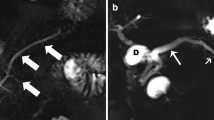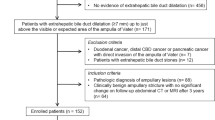Abstract
Objectives
To develop and validate a CT nomogram and a radiomics nomogram to differentiate mass-forming chronic pancreatitis (MFCP) from pancreatic ductal adenocarcinoma (PDAC) in patients with chronic pancreatitis (CP).
Methods
In this retrospective study, the data of 138 patients with histopathologically diagnosed MFCP or PDAC treated at our institution were retrospectively analyzed. Two radiologists analyzed the original cross-sectional CT images based on predefined criteria. Image segmentation, feature extraction, and feature reduction and selection were used to create the radiomics model. The CT and radiomics models were developed using data from a training cohort of 103 consecutive patients. The models were validated in 35 consecutive patients. Multivariable logistic regression analysis was conducted to develop a model for the differential diagnosis of MFCP and PDAC and visualized as a nomogram. The nomograms’ performances were determined based on their differentiating ability and clinical utility.
Results
The mean age of patients was 53.7 years, 75.4% were male. The CT nomogram showed good differentiation between the two entities in the training (area under the curve [AUC], 0.87) and validation (AUC, 0.94) cohorts. The radiomics nomogram showed good differentiation in the training (AUC, 0.91) and validation (AUC, 0.93) cohorts. Decision curve analysis showed that patients could benefit from the CT and radiomics nomograms, if the threshold probability was 0.05–0.85 and > 0.05, respectively.
Conclusions
The two nomograms reasonably accurately differentiated MFCP from PDAC in patients with CP and hold potential for refining the management of pancreatic masses in CP patients.
Key Points
• A CT nomogram and a computed tomography-based radiomics nomogram reasonably accurately differentiated mass-forming chronic pancreatitis from pancreatic ductal adenocarcinoma in patients with chronic pancreatitis (CP).
• The two nomograms can monitor the cancer risk in patients with CP and hold promise to optimize the management of pancreatic masses in patients with CP.






Similar content being viewed by others
Abbreviations
- AIC:
-
Akaike information criterion
- AUC:
-
Area under the curve
- BMI:
-
Body mass index
- CI:
-
Confidence interval
- CT:
-
Computed tomography
- DCA:
-
Decision curve analysis
- DECT:
-
Dual-energy computed tomography
- DWI:
-
Diffusion-weighted imaging
- ICC:
-
Intraclass correlation coefficient
- LASSO:
-
Least absolute shrinkage and selection operator
- MFCP:
-
Mass-forming chronic pancreatitis
- MRI:
-
Magnetic resonance imaging
- OR:
-
Odds ratio
- OS:
-
Overall survival
- PDAC:
-
Pancreatic ductal adenocarcinoma
- PV:
-
Predictive value
- ROC:
-
Receiver operating characteristic
- SE:
-
Standard error
References
Schima W, Böhm G, Rösch CS, Klaus A, Függer R, Kopf H (2020) Mass-forming pancreatitis versus pancreatic ductal adenocarcinoma: CT and MR imaging for differentiation. Cancer Imaging 20:52
Yin Q, Zou X, Zai X et al (2015) Pancreatic ductal adenocarcinoma and chronic mass-forming pancreatitis: differentiation with dual-energy MDCT in spectral imaging mode. Eur J Radiol 84:2470–2476
Kirkegård J, Mortensen FV, Cronin-Fenton D (2017) Chronic pancreatitis and pancreatic cancer risk: a systematic review and meta-analysis. Am J Gastroenterol 112:1366–1372
Harmsen FR, Domagk D, Dietrich CF, Hocke M (2018) Discriminating chronic pancreatitis from pancreatic cancer: contrast-enhanced EUS and multidetector computed tomography in direct comparison. Endosc Ultrasound 7:395–403
Zakaria HM, Mohamed A, Alsebaey A, Omar H, Elazab D, Gaballa NK (2018) Prognostic factors following pancreaticoduodenectomy for pancreatic ductal adenocarcinoma. Int Surg J 5:3877–3882
Aslan S, Nural MS, Camlidag I, Danaci M (2019) Efficacy of perfusion CT in differentiating of pancreatic ductal adenocarcinoma from mass-forming chronic pancreatitis and characterization of isoattenuating pancreatic lesions. Abdom Radiol (NY) 44:593–603
Sandrasegaran K, Nutakki K, Tahir B, Dhanabal A, Tann M, Cote GA (2013) Use of diffusion-weighted MRI to differentiate chronic pancreatitis from pancreatic cancer. AJR Am J Roentgenol 201:1002–1008
Elsherif SB, Virarkar M, Javadi S, Ibarra-Rovira JJ, Tamm EP, Bhosale PR (2020) Pancreatitis and PDAC: association and differentiation. Abdom Radiol (NY) 45:1324–1337
Granata V, Grassi R, Fusco R et al (2021) Pancreatic cancer detection and characterization: state of the art and radiomics. Eur Rev Med Pharmacol Sci 25:3684–3699
Abunahel BM, Pontre B, Kumar H, Petrov MS (2021) Pancreas image mining: a systematic review of radiomics. Eur Radiol 31:3447–3467
Deng Y, Ming B, Zhou T et al (2021) Radiomics model based on MR images to discriminate pancreatic ductal adenocarcinoma and mass-forming chronic pancreatitis lesions. Front Oncol 11:620981
Ren S, Zhang J, Chen J et al (2019) Evaluation of texture analysis for the differential diagnosis of mass-forming pancreatitis from pancreatic ductal adenocarcinoma on contrast-enhanced CT images. Front Oncol 9:1171
Moons KG, Altman DG, Reitsma JB et al (2015) Transparent Reporting of a multivariable prediction model for Individual Prognosis or Diagnosis (TRIPOD): explanation and elaboration. Ann Intern Med 162:W1–W73
Tandon RK, Sato N, Garg PK, Consensus Study G (2002) Chronic pancreatitis: Asia-Pacific consensus report. J Gastroenterol Hepatol 17:508–518
Watanabe H, Okada M, Kaji Y et al (2009) New response evaluation criteria in solid tumours-revised RECIST guideline (version 1.1). Gan To Kagaku Ryoho 36:2495–2501
Jeon SK, Lee JM, Joo I et al (2017) Nonhypervascular pancreatic neuroendocrine tumors: differential diagnosis from pancreatic ductal adenocarcinomas at MR imaging-retrospective cross-sectional study. Radiology 284:77–87
Eloubeidi MA, Luz LP, Tamhane A, Khan M, Buxbaum JL (2013) Ratio of pancreatic duct caliber to width of pancreatic gland by endosonography is predictive of pancreatic cancer. Pancreas 42:670–679
Ichikawa T, Sou H, Araki T et al (2001) Duct-penetrating sign at MRCP: usefulness for differentiating inflammatory pancreatic mass from pancreatic carcinomas. Radiology 221:107–116
Fielding DI, Kurimoto N (2013) EBUS-TBNA/staging of lung cancer. Clin Chest Med 34:385–394
van Griethuysen JJM, Fedorov A, Parmar C et al (2017) Computational radiomics system to decode the radiographic phenotype. Cancer Res 77:e104–e107
Chalkidou A, O'Doherty MJ, Marsden PK (2015) False discovery rates in PET and CT studies with texture features: a systematic review. PLoS One 10:e0124165
Lubner MG, Smith AD, Sandrasegaran K, Sahani DV, Pickhardt PJ (2017) CT texture analysis: definitions, applications, biologic correlates, and challenges. Radiographics 37:1483–1503
Shrout PE, Fleiss JL (1979) Intraclass correlations: uses in assessing rater reliability. Psychol Bull 86:420–428
Portet S (2020) A primer on model selection using the Akaike Information Criterion. Infect Dis Model 5:111–128
DeLong ER, DeLong DM, Clarke-Pearson DL (1988) Comparing the areas under two or more correlated receiver operating characteristic curves: a nonparametric approach. Biometrics 44:837–845
Choueiri NE, Balci NC, Alkaade S, Burton FR (2010) Advanced imaging of chronic pancreatitis. Curr Gastroenterol Rep 12:114–120
Wolske KM, Ponnatapura J, Kolokythas O, Burke LMB, Tappouni R, Lalwani N (2019) Chronic pancreatitis or pancreatic tumor? A problem-solving approach. Radiographics 39:1965–1982
Yadav AK, Sharma R, Kandasamy D et al (2016) Perfusion CT - can it resolve the pancreatic carcinoma versus mass forming chronic pancreatitis conundrum? Pancreatology 16:979–987
Qin WH, Yang ZS, Li M et al (2020) High serum levels of cholesterol increase antitumor functions of nature killer cells and reduce growth of liver tumors in mice. Gastroenterology 158:1713–1727
Funding
This work was supported in part by the National Science Foundation for Scientists of China (81871352, 82171915, and 82171930), The Natural Science Foundation of Shanghai Science and Technology Innovation Action Plan (21ZR1478500, 21Y11910300), Clinical Research Plan of SHDC (SHDC2020CR4073), and 234 Platform Discipline Consolidation Foundation Project (2019YPT001, 2020YPT001).
Author information
Authors and Affiliations
Corresponding authors
Ethics declarations
Guarantor
The scientific guarantor of this publication is Yun Bian.
Conflict of interest
The authors of this manuscript declare no relationships with any companies, whose products or services may be related to the subject matter of the article.
Statistics and biometry
A professor of Biostatistics (Dr Pin Wu, PhD) was consulted for specialist advice.
Informed consent
Written informed consent was waived by the Institutional Review Board.
Ethical approval
Institutional Review Board approval was obtained by the Changhai Hospital.
Methodology
• retrospective
• diagnostic or prognostic study
• performed at one institution
Additional information
Publisher’s note
Springer Nature remains neutral with regard to jurisdictional claims in published maps and institutional affiliations.
Rights and permissions
About this article
Cite this article
Zhang, H., Meng, Y., Li, Q. et al. Two nomograms for differentiating mass-forming chronic pancreatitis from pancreatic ductal adenocarcinoma in patients with chronic pancreatitis. Eur Radiol 32, 6336–6347 (2022). https://doi.org/10.1007/s00330-022-08698-3
Received:
Revised:
Accepted:
Published:
Issue Date:
DOI: https://doi.org/10.1007/s00330-022-08698-3




